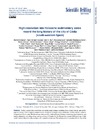Please use this identifier to cite or link to this item:
https://accedacris.ulpgc.es/jspui/handle/10553/72995
| Title: | High-resolution late Holocene sedimentary cores record the long history of the city of Cádiz (south-western Spain) | Authors: | Salomon, Ferréol Bernal-Casasola, Darío Díaz, José J. Lara, Macarena Domínguez-Bella, Salvador Ertlen, Damien Wassmer, Patrick Adam, Pierre Schaeffer, Philippe Hardion, Laurent Vittori, Cécile Chapkanski, Stoil Delile, Hugo Schmitt, Laurent Preusser, Frank Trautmann, Martine Masi, Alessia Vignola, Cristiano Sadori, Laura Morales Mateos, Jacob Bentejui Vidal Matutano, Paloma Robin, Vincent Keller, Benjamin Sanchez Bellón, Ángel Martínez López, Javier Rixhon, Gilles |
UNESCO Clasification: | 550501 Arqueología | Issue Date: | 2020 | Project: | HAR2016-78691-P | Journal: | Scientific Drilling | Abstract: | Today, coastal cities worldwide are facing major changes resulting from climate change and anthropogenic forcing, which requires adaptation and mitigation strategies to be established. In this context, sedimentological archives in many Mediterranean cities record a multi-millennial history of environmental dynamics and human adaptation, revealing a long-lasting resilience. Founded by the Phoenicians around 3000 years ago, Cádiz (south-western Spain) is a key example of a coastal resilient city. This urban centre is considered to be one of the first cities of western Europe and has experienced major natural hazards during its long history, such as coastal erosion, storms, and also tsunamis (like the one in 1755 CE following the destructive Lisbon earthquake). In the framework of an international, joint archaeological and geoarchaeological project, three cores have been drilled in a marine palaeochannel that ran through the ancient city of Cádiz. These cores reveal a ≥50 m thick Holocene sedimentary sequence. Importantly, most of the deposits date from the 1st millennium BCE to the 1st millennium CE. This exceptional sedimentary archive will allow our scientific team to achieve its research goals, which are (1) to reconstruct the palaeogeographical evolution of this specific coastal area; (2) to trace the intensity of activities of the city of Cádiz based on archaeological data, as well as geochemical and palaeoecological indicators; and (3) to identify and date high-energy event deposits such as storms and tsunamis. | URI: | https://accedacris.ulpgc.es/handle/10553/72995 | ISSN: | 1816-3459 | DOI: | 10.5194/sd-27-35-2020 | Source: | Scientific Drilling [1816-3459], n. 27, p. 35–47 |
| Appears in Collections: | Artículos |
WEB OF SCIENCETM
Citations
6
checked on Jun 8, 2025
Page view(s)
223
checked on Sep 27, 2025
Download(s)
155
checked on Sep 27, 2025
Google ScholarTM
Check
Altmetric
Share
Export metadata
Items in accedaCRIS are protected by copyright, with all rights reserved, unless otherwise indicated.
